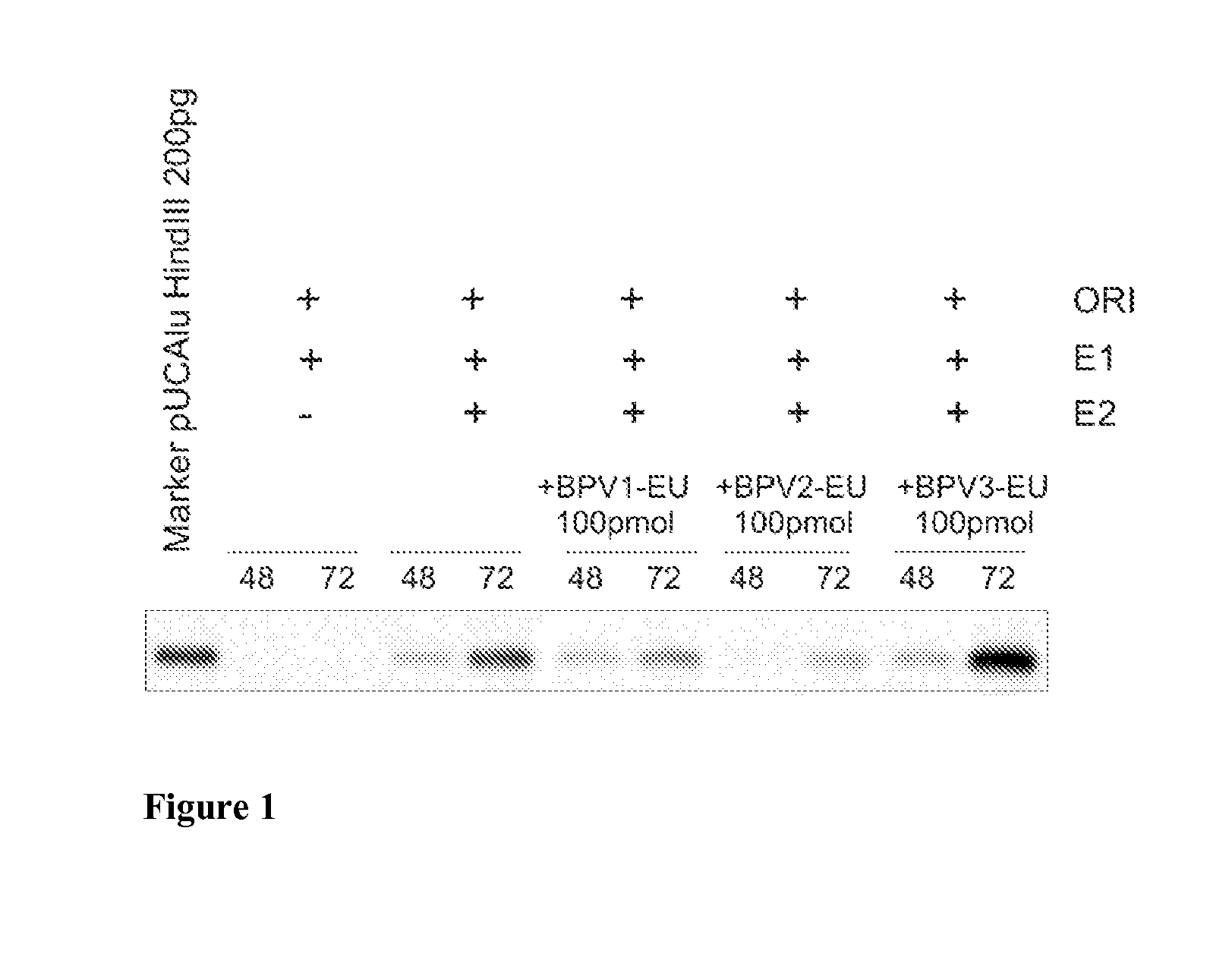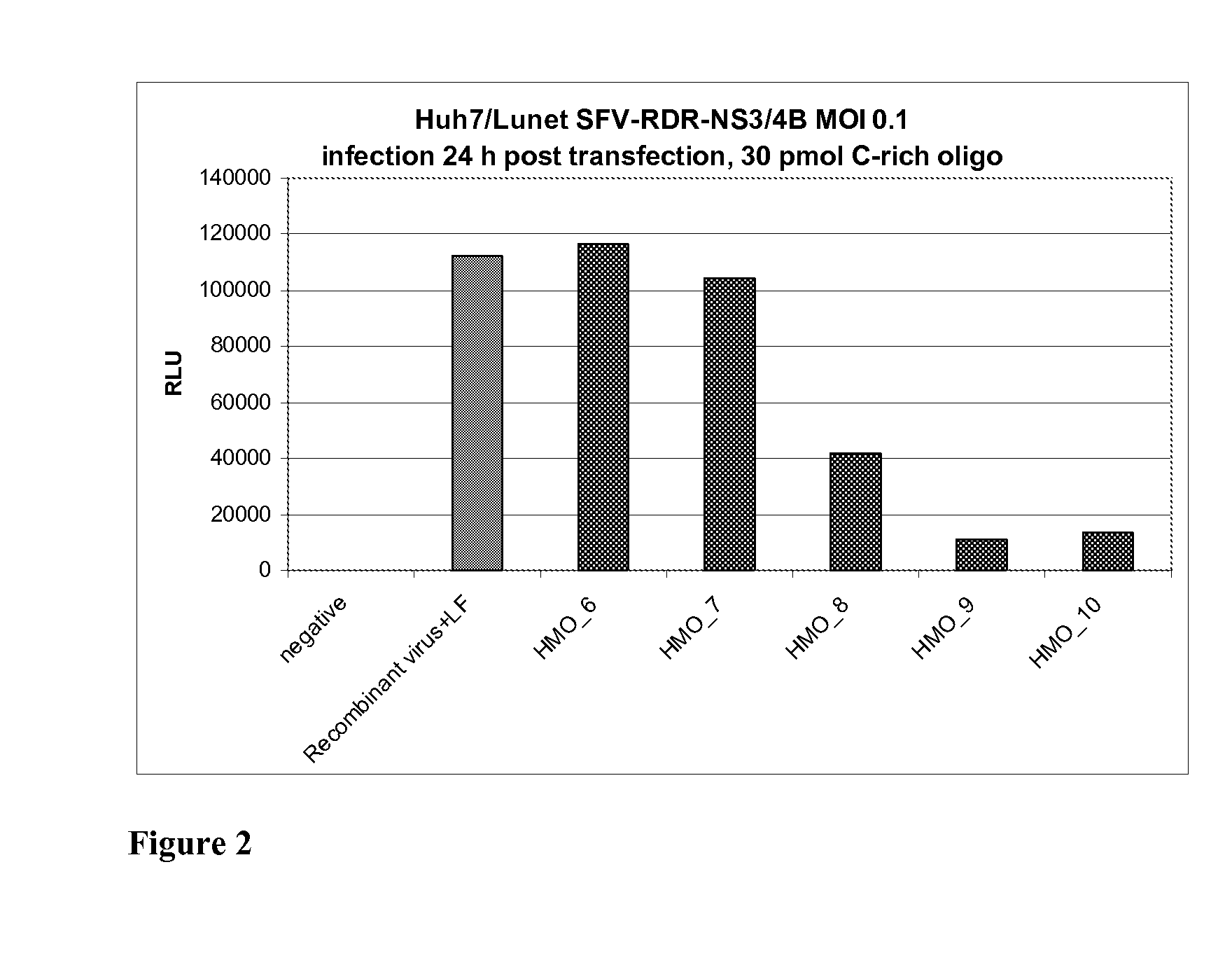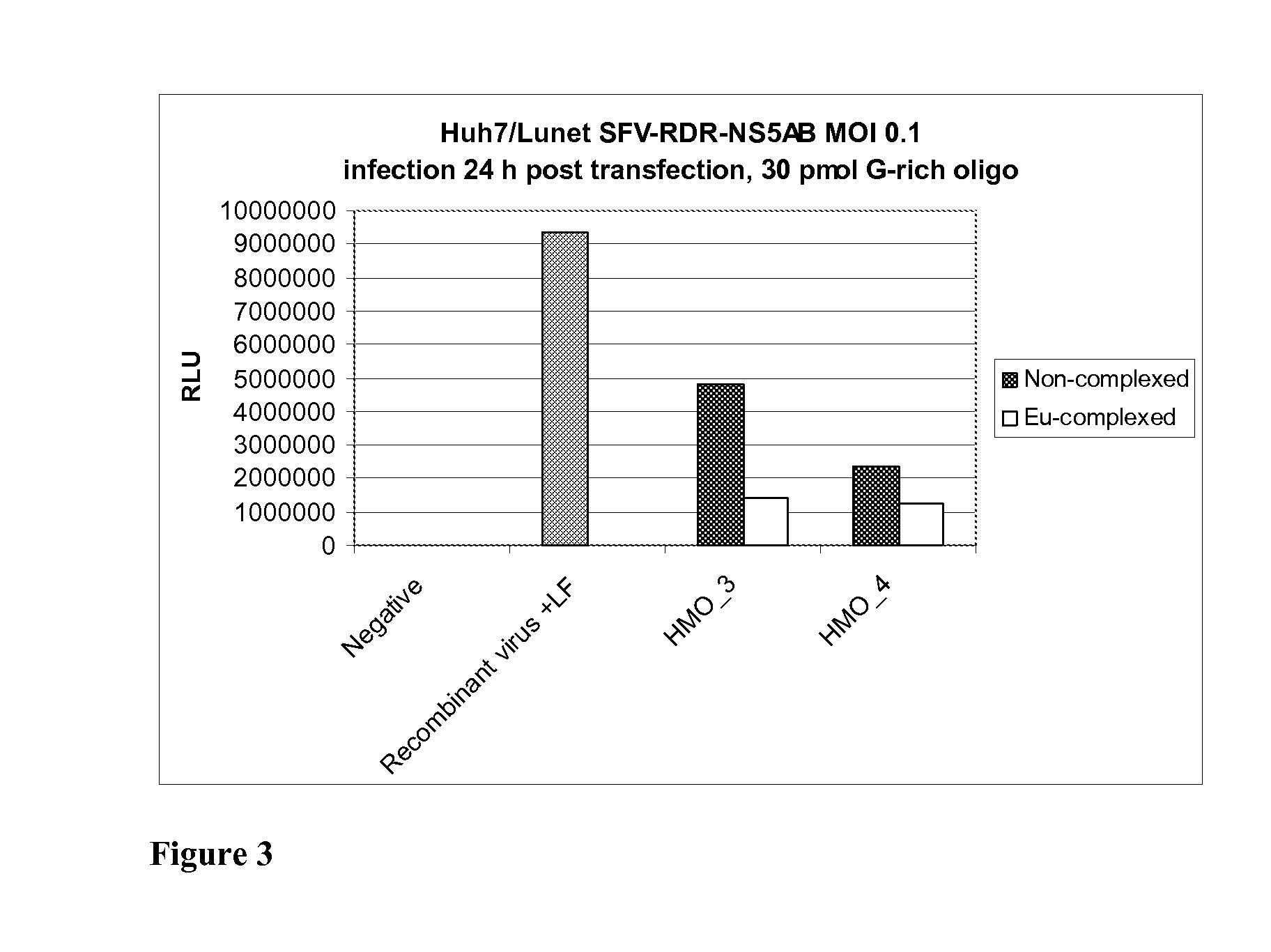Use of Oligonucleotides with Modified Bases as Antiviral Agents
a technology of oligonucleotides and antiviral agents, which is applied in the field of use of oligonucleotide analogs, can solve the problems that the cells carrying these proviruses cannot be targeted by conventional antiviral agents or systems, and many of these diseases are often fatal, so as to increase the binding ability
- Summary
- Abstract
- Description
- Claims
- Application Information
AI Technical Summary
Benefits of technology
Problems solved by technology
Method used
Image
Examples
example 1
Use of Modified Oligonucleotide for Inhibition of the Semliki Forest Virus
[0230]To determine the effects of modified oligonucleotides on viral gene replication, antisense oligonucleotides against Semliki Forest virus (SFV), a rapid (acute) positive strand RNA virus from genus Alphavirus family Togaviridae, were generated and inhibition of viral genome replication measured.
[0231]A list of oligonucleotides and targets inside of the SFV viral genome is set out in Table 1.
TABLE 1Sequence of compoundPresenceTargetOrientation(5′-3′), 5′ end had of organicregion ofwith respectCodeamino groupsRNAseSFV genometo targetA6TTA ATC TCT CXC GTA GCGNo5′ UTRantisenseGAG XT(SEQ ID NO. 1)A6-NTTA ATC TCT CXC GTA GCGYes5′ UTRantisenseGAG XT(SEQ ID NO. 1)A7ATX TTX TCG TCG CCG ATGNonsP4antisenseAAG XC(SEQ ID NO. 2)A7-NATX TTX TCG TCG CCG ATGYesnsP4antisenseAAG XC(SEQ ID NO. 2)A8GCC TTC ATC GXC GAC XACNonsP4senseAAC AT(SEQ ID NO. 3)A8-NGCC TTC ATC GXC GAC XACYesnsP4senseAAC AT(SEQ ID NO. 3)X - modified bas...
example 2
Use of Modified Oligonucleotide for Inhibition of the Hepatitis C Virus
[0234]To determine the effects of modified oligonucleotides on viral gene replication, antisense oligonucleotides against Hepatitis C virus (HCV), a slow (chronic) positive strand RNA virus from genus Hepacivirus, family Flaviviridae, were generated and inhibition of the viral genome replication measured.
[0235]A list of oligonucleotides and targets inside the HCV viral genome is given in Table 3.
TABLE 3PresenceTargetOrientationSequence of compoundofregion ofwith(5′-3′), 5′ end hadorganicHCVrespect toCodeamino groupsRNAsegenometargetB4CTTTYACAGATAACGAYAAGGTCNoNS5Bantisense(SEQ ID NO. 4)B4-NCTTTYACAGATAACGAYAAGGTCYesNS5Bantisense(SEQ ID NO. 4)B6CTTTCACAXATAACGACAAXGTCNoNS5Bantisense(SEQ ID NO. 4)B6-NCTTTCACAXATAACGACAAXGTCYesNS5Bantisense(SEQ ID NO. 4)X - modified base, 8-oxo-dG; Y- modified base, 5-OH-dCNS5B - conserved part of the coding region for viral RNA polymerase, the non-structural protein 5B
[0236]Analysis...
example 3
Use of Modified Oligonucleotide for Inhibition of Tat-Activated Gene Expression of Human Immunodeficiency Virus Type 1 (HIV-1)
[0239]To determine the effects of modified oligonucleotides on viral gene replication, antisense oligonucleotides against HIV-1, genus Lentivirus family Retroviridae, were generated and inhibition of viral genome replication measured.
[0240]A list of oligonucleotides and targets inside the HIV viral genome are given in Table 5.
TABLE 5PresenceTargetOrientationSequence of compoundofregion ofwith(5′-3′), 5′ end hadorganicHIVrespect toCodeamino groupsRNAsegenometargetA11CTA XCC AGA GAG CTC CCANoTarantisenseGXC TC(SEQ ID NO. 6)A11-CTA XCC AGA GAG CTC CCAYesTarantisenseNGXC TC(SEQ ID NO. 6)A12TTT CTT XTG AAA GAA ACTNoTatantisenseTGX CA(SEQ ID NO. 7)A12-TTT CTT XTG AAA GAA ACTYesTatantisenseNTGX CA(SEQ ID NO. 7)A13CTA GCC AGA GAG CTC CCANoTarantisenseGGC TC(SEQ ID NO. 8)A14TTT CTT GTG AAA GAA ACTNoTatantisenseTGG CA(SEQ ID NO. 9)X - modified base, 8-oxo-dGTar - conse...
PUM
| Property | Measurement | Unit |
|---|---|---|
| Fraction | aaaaa | aaaaa |
| Fraction | aaaaa | aaaaa |
| Fraction | aaaaa | aaaaa |
Abstract
Description
Claims
Application Information
 Login to View More
Login to View More - R&D
- Intellectual Property
- Life Sciences
- Materials
- Tech Scout
- Unparalleled Data Quality
- Higher Quality Content
- 60% Fewer Hallucinations
Browse by: Latest US Patents, China's latest patents, Technical Efficacy Thesaurus, Application Domain, Technology Topic, Popular Technical Reports.
© 2025 PatSnap. All rights reserved.Legal|Privacy policy|Modern Slavery Act Transparency Statement|Sitemap|About US| Contact US: help@patsnap.com



